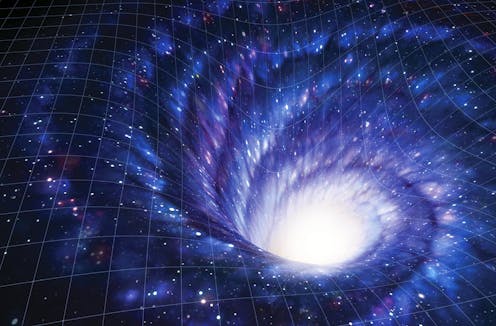What are wormholes? An astrophysicist explains these shortcuts through space-time
- Written by Dejan Stojkovic, Professor of Physics, University at Buffalo

Because of these interesting features, many science fiction writers use wormholes in novels and movies. However, scientists have been just as captivated by the idea of wormholes as writers have.
While researchers have never found a wormhole in our universe, scientists often see wormholes described in the solutions to important physics equations. Most prominently, the solutions to the equations behind Einstein’s theory of space-time and general relativity[8] include wormholes. This theory describes the shape of the universe and how stars, planets and other objects move throughout it. Because Einstein’s theory has been tested many, many times and found to be correct every time[9], some scientists do expect wormholes to exist somewhere out in the universe.
But, other scientists think wormholes can’t possibly exist because they would be too unstable.
The constant pull of gravity affects every object in the universe, including Earth. So gravity would have an effect on wormholes, too. The scientists who are skeptical about wormholes believe that after a short time the middle of the wormhole would collapse under its own gravity[10], unless it had some force pushing outward from inside the wormhole to counteract that force. The most likely way it would do that is using what’s called “negative energies,” which would oppose gravity[11] and stabilize the wormhole.
But as far as scientists know, negative energies can be created only in amounts much too small[12] to counteract a wormhole’s own gravity. It’s possible that the Big Bang created teeny, tiny wormholes with small amounts of negative energies way back at the beginning of the universe, and over time these wormholes have stretched out[13] as the universe has expanded.
In this short video by Fusion, a Caltech professor sums up what wormholes are and the stability question that’s boggling scientists.Just like black holes?
While wormholes are interesting objects to think about, they still aren’t accepted in mainstream science. But that doesn’t mean they’re not real – black holes, which we astrophysicists know abound in our universe, weren’t accepted when scientists first suggested they existed, back in the 1910s.
Einstein first formulated his famous field equations in 1915, and German scientist Karl Schwarzschild found a way to mathematically describe black holes after only one year[14]. However, this description was so peculiar that the leading scientists of that era refused to believe that black holes could actually exist in nature. It took people 50 years to start taking black holes seriously – the term “black hole” wasn’t even coined until 1967[15].
The same could happen with wormholes. It may take scientists a little while to come up with a consensus about whether or not they can exist. But if they do find strong evidence pointing to the existence of wormholes – which they may be able to do by looking at odd movements in star orbits[16] – the discovery will shape how scientists see and understand the universe.
Hello, curious kids! Do you have a question you’d like an expert to answer? Ask an adult to send your question to CuriousKidsUS@theconversation.com[17]. Please tell us your name, age and the city where you live.
And since curiosity has no age limit – adults, let us know what you’re wondering, too. We won’t be able to answer every question, but we will do our best.
References
- ^ Curious Kids (theconversation.com)
- ^ curiouskidsus@theconversation.com (theconversation.com)
- ^ a tunnel between two distant points (www.sciencefocus.com)
- ^ cut the travel time (doi.org)
- ^ through space-time (doi.org)
- ^ like me (scholar.google.com)
- ^ Victor Habbick Visions/Science Photo Library via Getty Images (www.gettyimages.com)
- ^ theory of space-time and general relativity (doi.org)
- ^ correct every time (doi.org)
- ^ collapse under its own gravity (doi.org)
- ^ oppose gravity (doi.org)
- ^ too small (doi.org)
- ^ stretched out (doi.org)
- ^ only one year (doi.org)
- ^ until 1967 (www.physicsoftheuniverse.com)
- ^ star orbits (doi.org)
- ^ CuriousKidsUS@theconversation.com (theconversation.com)
Authors: Dejan Stojkovic, Professor of Physics, University at Buffalo

